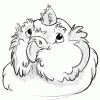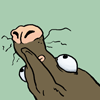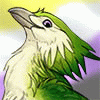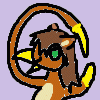
Commission for Ash :B
If you want a reference like this, it'll come in at about $40.
Larger ones with more space and more details will come in over $50.
Based on a white-faced whistling duck :D
This is watercolours.
If you want a reference like this, it'll come in at about $40.
Larger ones with more space and more details will come in over $50.
Based on a white-faced whistling duck :D
This is watercolours.
Category Artwork (Traditional) / Animal related (non-anthro)
Species Dinosaur
Size 999 x 653px
File Size 889.9 kB
Maniraptors are closer to birds than they are to reptiles, so that comparison is moot.
As for kiwis, they're an oddball of a bird. They lay the largest eggs in comparison to body size; so the young are already very developed when they hatch, unlike in dinosaurs where almost all the offspring were fairly small when they emerged. Adding to that, New Zealand had no terrestrial mammalian predators up until man arrived, which meant that young kiwis didn't need as much parental protection.
If you take into consideration the larger, more dromaeosaur sized ratites who have a body/egg size ratio closer to that of maniraptors, they are committed parents who can invest up to nine months in rearing their offspring -in the case of the cassowary-.
As for kiwis, they're an oddball of a bird. They lay the largest eggs in comparison to body size; so the young are already very developed when they hatch, unlike in dinosaurs where almost all the offspring were fairly small when they emerged. Adding to that, New Zealand had no terrestrial mammalian predators up until man arrived, which meant that young kiwis didn't need as much parental protection.
If you take into consideration the larger, more dromaeosaur sized ratites who have a body/egg size ratio closer to that of maniraptors, they are committed parents who can invest up to nine months in rearing their offspring -in the case of the cassowary-.
Still, ratites exhibit features common to animals subjected to parental care, like distinct facial features.
Troodontid juveniles not only are like miniature adults, they also have well developed brains that suggest a high level of independence.
Short term parental care isn't out of question, but megapode style superprecociality seems to have occured. The fact that juvenile Deinonychus have longer arms than the adults seems to indeed imply that juveniles occupied distinct ecological niches.
Troodontid juveniles not only are like miniature adults, they also have well developed brains that suggest a high level of independence.
Short term parental care isn't out of question, but megapode style superprecociality seems to have occured. The fact that juvenile Deinonychus have longer arms than the adults seems to indeed imply that juveniles occupied distinct ecological niches.
LAWL harpier lost the game at "reptile" phff, they obviously where cared for by the parents maybe even the..flock, even crocodilians who yes are reptiles but are more closely related to birds anyway care for their young for years aswell, theropods are pretty much birds and its getting more absurd everyday to think otherwise especially with all the new fossil evidence (and even chromosome) that people are finding, whelps back to the original note Omfg baybehs these little guys are so cute, I adore chicks *wantwantwants*

 FA+
FA+

























Comments